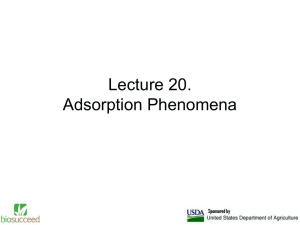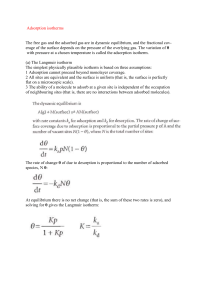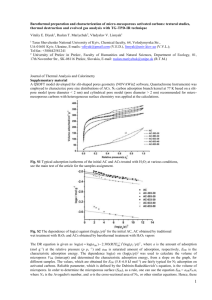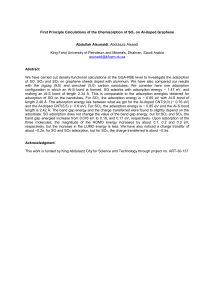Template for Electronic Submission to ACS Journals
advertisement
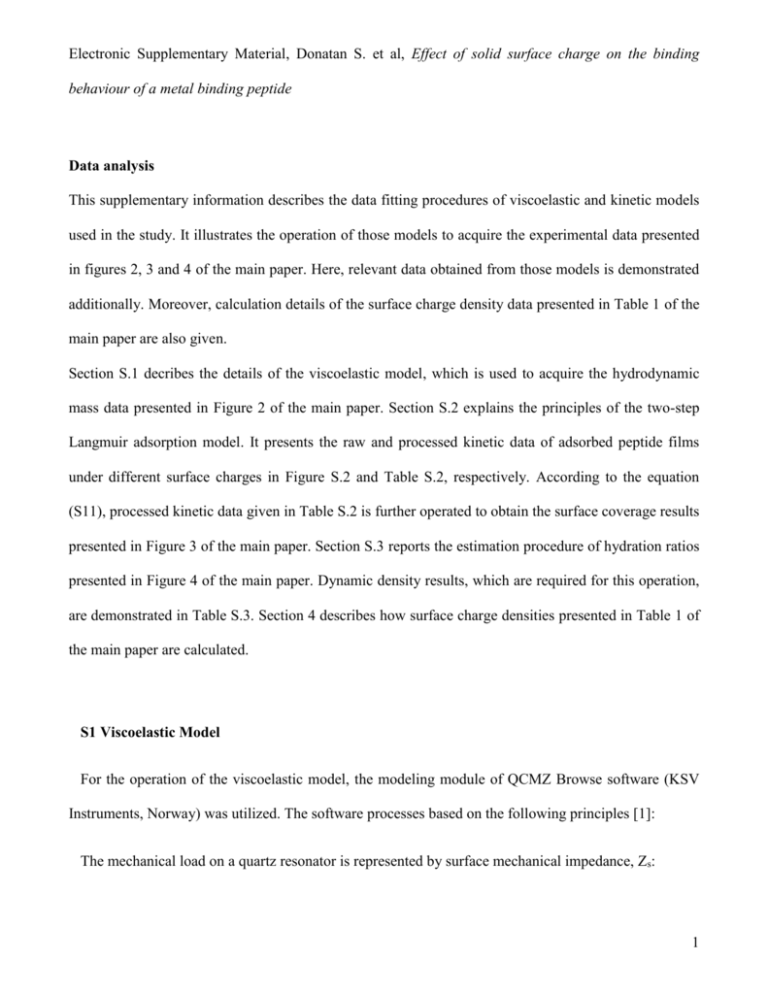
Electronic Supplementary Material, Donatan S. et al, Effect of solid surface charge on the binding behaviour of a metal binding peptide Data analysis This supplementary information describes the data fitting procedures of viscoelastic and kinetic models used in the study. It illustrates the operation of those models to acquire the experimental data presented in figures 2, 3 and 4 of the main paper. Here, relevant data obtained from those models is demonstrated additionally. Moreover, calculation details of the surface charge density data presented in Table 1 of the main paper are also given. Section S.1 decribes the details of the viscoelastic model, which is used to acquire the hydrodynamic mass data presented in Figure 2 of the main paper. Section S.2 explains the principles of the two-step Langmuir adsorption model. It presents the raw and processed kinetic data of adsorbed peptide films under different surface charges in Figure S.2 and Table S.2, respectively. According to the equation (S11), processed kinetic data given in Table S.2 is further operated to obtain the surface coverage results presented in Figure 3 of the main paper. Section S.3 reports the estimation procedure of hydration ratios presented in Figure 4 of the main paper. Dynamic density results, which are required for this operation, are demonstrated in Table S.3. Section 4 describes how surface charge densities presented in Table 1 of the main paper are calculated. S1 Viscoelastic Model For the operation of the viscoelastic model, the modeling module of QCMZ Browse software (KSV Instruments, Norway) was utilized. The software processes based on the following principles [1]: The mechanical load on a quartz resonator is represented by surface mechanical impedance, Zs: 1 Z s T v xy (S1) y 0 x where Txy is sinusoidal steady-state shear stress imposed on the contacting medium by the quartz crystal, and vx is the resulting x-directed surface shear particle velocity. The nature of loading will directly change the surface mechanical impedance. Following expressions represent liquid and viscoelastic loadings: Z liquid s l l 2 Z Z s film s 1/ 2 1 j liquid cosh h film sinh Zs f Z s film liquid cosh h Z s sinh f Z s (S2) h h f (S3) f where Zsfilm =(fG)1/2 is the surface mechanical impedance of the viscoelastic film, Zsliquid is the surface mechanical impedance of a Newtonian liquid, γ = jω(fG)1/2 is the complex wave propagation constant, where hf, f and G refer to the film thickness, film density and elastic modulus of the viscoelastic layer. Using multidimensional information obtained from overtone frequencies, mechanical properties (effective thickness, hydrodynamic density, viscosity and elastic modulus) of the viscoelastic film can be extracted by fitting the acquired impedance data from QCM to the equation (S3). Hydrodynamic mass data is further calculated by multiplying the hydrodynamic density to the effective thickness. S2 Modified Two-Step Langmuir Adsorption Model 1:1 Langmuir adsorption model assumes that the adsorbate molecules adhere to the available sites of the given surface and form a monolayer, meantime the adsorbed molecules on the available adjacent sites are not interacting with each other [2]. Monolayer surface coverage can be considered as a site filling procedure, where a dynamic process (adsorption is followed by desorption) takes place. At 2 equilibrium conditions, the amount of adsorbed molecules is equal to the amount of desorbed molecules. The adsorption rate depends on the concentration of adsorbate [3]. Along with the stated assumptions, the adsorption model is given in the following expression: k a 1 C k d t (S4) where is fraction of surface covered by the adsorbate molecules, C is concentration of the adsorbate, ka and kd are assosication and dissociation constants, respectively. By integrating the equation (S4), the surface coverage can be attained as a function of time: (t ) C 1 exp kaC kd t C kd ka (S5) As time approaches infinity at equilibrium conditions, the limit of equation (S5) is taken to calculate the surface coverage: max ka 1 max kaC kd C kd ka (S6) The surface coverage can be replaced by signal of the applied technique, in this case the frequency shift obtained from QCM: F Fmax 1 C kd ka (S7) Equation (S4) describes the simple 1:1 Langmuir model, where kd/ka refers to the dissociation constant Kd, which is equal to the inverse value of adsorption equilibrium constant Keq. Although Langmuir adsorption model requires desorption, this model fits well also to the irreversible protein adsorption data [2]. Hence, Langmuir model is commonly preferred in protein adsorption studies due to 3 its simplicity. However, the recognition process for 3rGBP1 molecule is more complex following two distinct regimes [4]. Therefore, the simple Langmuir model was combined with two-state conformational change adsorption model. Conformational change adsorption model is usually applied to ligand (A) - analyte (B) interactions, where the molecules first form an initial complex (AB) and then a more stable complex (AB*), usually through conformational changes at the interface [5]: k a1 ka2 k d1 kd 2 A B AB AB * (S8) The adsorption equilibrium constant (Keq) of this model is defined as following: K eq (k a1 / k d1 )(1 k a2 / k d2 ) (S9) Both models are combined by placing equation (S9) into equation (S7): F Fmax 1 C ( ka / kd )(11ka 1 1 Fmax 2 / kd 2 ) 1 C ( Keq )(11 Keq 1 (S10) 2 ) Time dependent QCM data under applied potentials (Figure S2) was fit to the equation (S10), using least square curve fitting algorithm. Binding parameters; Keq1, Keq2 were extracted (Table S2). The surface coverage; in which percentage the entire surface covered by the adsorbate was estimated using the following expression: ( ) F 1 Fmax C ( Keq )(11 Keq 1 (S11) 2 ) Free energies were calculated using the given equation: 4 G RT ln(( K eq1 )(1 K eq2 )) (S12) where G is the binding energy (kcal/mol), R is the ideal gas constant and T is the temperature in Kelvin. Figure S2. Time dependent QCM data under applied potentials Table S2. Adsorption equilibrium coefficients (stepwise; Keq1, Keq2 and total; Keq) and free energy (Gads) for 3rGBP1 at applied surface charge densities (). (C/cm2) Keq1 x 104 (M-1) Keq2 x 101 (M-1) Keq x 106 (M-1) Gads (kcal/mol) 9 6.130.01 7.362.45 4.571.50 -9.060.30 0 6.130.05 2.260.60 1.450.29 -8.370.26 -3 6.130.04 1.780.45 1.150.28 -8.220.22 -7 6.130.19 3.581.12 2.250.76 -8.640.24 S3 Hydration Ratio Estimation of Adsorbed Peptide Films Since QCM measures the adsorbed peptide film coupled with water, the dynamic density of adsorbed 5 peptide films can be assumed as a mixture of water and peptide molecules: film peptidex water (1 x) (S13) where x is the ratio of pure peptide content, and 1-x is the hydration ratio in the adsorbed films, respectively. Table S3. Dynamic density (ρeff) of adsorbed 3rGBP1 molecules from 1.2 M peptide concentration under applied surface charges. (C/cm2) ρeff (g/cm3) 9 0.9540.05 0 0.9440.02 -3 0.9250.03 -7 0.9410.06 Dynamic density results of adsorbed 3rGBP1 molecules from 1.2 M peptide concentration under applied surface charges are given in Table S3. S4 Calculation of Surface Charge Densities The gold surface in the electrochemical cell was exposed to phosphate buffer solution at pH 7.4, which does not contain any peptide. Then, a frequency of 60 Hz and amplitude of 3 mV was applied to the working electrode (i.e. gold surface), which was polarized, with a scan rate of 10 mV/s. Hence, the differential capacity curve of the gold-phosphate buffer interface was obtained at varying potentials using AC impedance technique (Figure S3). For the calculation of surface charge densities, the differential capacitance data in Figure S3 was integrated at potentials given in Table 1 of the main paper according to the following expression [6]: 6 V C (V )V 0 (S14) Figure S3. Differential capacitance curve of the gold surface measured in 100 mM KCl containing phosphate solution at pH 7.4 References 1 Viitala, T. 2008 Modelling with dissipative QCM, application notes. Helsinki: KSV Instrument Ltd. 2 Schessler, H. M., Karpovich, D. S. & Blanchard, G. J. 1996 Quantitating the balance between enthalpic and entropic forces in alkanethiol/gold monolayer self assembly. J. Am. Chem. Soc., 118, 9645-9651. 3 Karpovich, D. S. & Blanchard, G. J. 1994 Direct measurement of the adsorption-kinetics of alkanethiolate self-assembled monolayers on a microcrystalline gold surface. Langmuir, 10, 33153322. (doi: 10.1021/la00021a066) 4 So, C. R., Tamerler, C. & Sarikaya, M. 2009 Adsorption, diffusion, and self-assembly of an engineered gold-binding peptide on Au (111) investigated by atomic force microscopy. Angew. 7 Chem. Int. Ed., 48, 5174-5177. (doi: 10.1002/anie.200805259) 5 Yowler, B. C. & Schengrund, C. L. 2004 Botulinum neurotoxin A changes conformation upon binding to ganglioside GT1b. Biochemistry, 43, 9725-9731. (doi: 10.1021/bi0494673) 6 Bockris, J. O. & Reddy, A. K. N. 1970 Modern electrochemistry: Fundamentals of electrodics, vol. 2, chapter 7. New York: Kluwer / Plenum Press. 8

